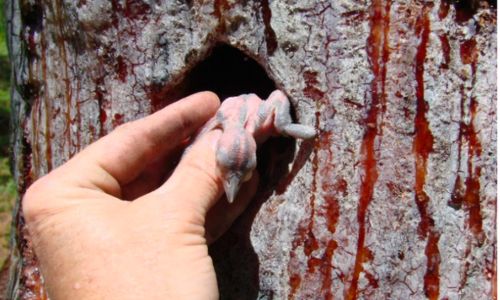Montgomery, AL – In the quiet depths of mature pine forests, a remarkable avian architect reigns supreme. The Red-cockaded Woodpecker (RCW), with its distinctive red cap and bold behavior, stands out as a symbol of ingenuity and resilience in North America’s natural landscape. Unlike its woodpecker peers who settle for decaying wood in lifeless trees, the RCW opts for vibrant living pines as the canvas for its extraordinary dwellings. This unique avian species holds the distinction of being North America’s sole woodpecker to exhibit such behavior, showcasing its adaptability and resourcefulness in the enchanting realm of pine forests.
Despite facing the threat of extinction and being classified as endangered by the US Fish and Wildlife Service, the RCW population is experiencing a remarkable resurgence, exceeding projections outlined in the National Forests in Alabama Forest Management Plan. This success story is a testament to the dedicated efforts of a collaborative team of individuals and organizations working tirelessly at a landscape level throughout the state.
Historically, Red-cockaded Woodpeckers inhabited various locations across the Southeastern United States, including Alabama, where they were prevalent in the districts of the National Forests. However, factors such as the loss and fragmentation of old-growth pine forests and fire suppression contributed to the decline of RCW populations. Nevertheless, native RCW populations persist in select districts such as Conecuh, Oakmulgee, Shoal Creek, and Talladega.
In response to these challenges, the National Forests in Alabama have undertaken significant efforts to revive native open pine ecosystems, crucial for the RCWs’ survival. Habitat restoration strategies include prescribed burning, timber harvesting, and planting of longleaf pine seedlings. Over the past 15 years, enhancing open pine ecosystems has been a priority, with silviculturists employing selective timber harvest strategies to preserve mature pines while thinning out younger trees to restore natural forest densities.
Artificial nest cavities play a crucial role in managing RCWs effectively. These birds typically excavate nesting sites in mature pines affected by red heart fungus decay. However, to expedite the process, biologists install artificial nest boxes on live pine trunks, providing suitable roosting and nesting spots for RCWs in younger trees. This initiative has contributed significantly to the growth of RCW populations in Alabama’s national forests, with numbers increasing from 177 to 399 active clusters over the last decade.
The success of RCW conservation efforts in Alabama is attributed to the collaborative endeavors of Forest Service biologists, technicians, and partnering organizations. By banding RCW nestlings and implementing habitat improvement initiatives, these individuals gain valuable insights into RCW behavior and facilitate the species’ recovery. Additionally, partnerships with wildlife agencies and non-governmental organizations further enhance habitat restoration efforts and contribute to the RCW’s resurgence.
Prescribed burning emerges as a vital tool in maintaining open forest overstory and promoting diverse herbaceous plant communities, benefiting not only RCWs but also various other wildlife species. By creating interconnected native landscapes, conservationists aim to establish vital corridors for imperiled species, ensuring their long-term survival.
As the longleaf and other pine forest canopies mature and age, natural cavity excavation is expected to increase, further bolstering RCW populations. With continued recruitment and successful nesting, the restoration of RCW populations across Alabama’s national forests remains a promising endeavor. Through collaborative conservation efforts and a commitment to habitat restoration, the Red-cockaded Woodpecker stands poised to thrive once again in the enchanting realm of mature pine forests.









